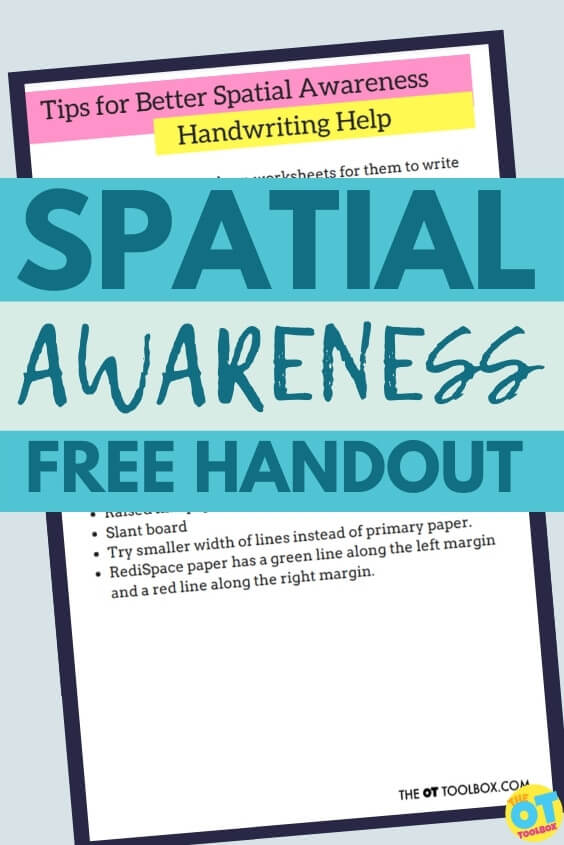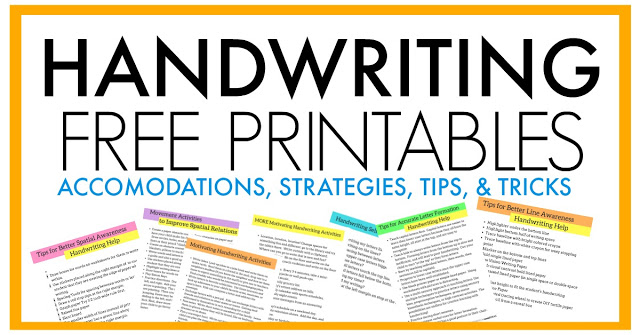Working to fix spacing in handwriting so the kids you serve can write legibly? Spatial awareness is a huge means to improving legible handwriting. Sometimes having a few strategies to actually improve the spacing between letters and words is so beneficial for accuracy and carryover in handwriting.
Today, I have another free handwriting handout as part of our handwriting tips and tricks series. If you’ve already signed up for this series, you have the free worksheet in your inbox. This is the space to access more spacing in handwriting resources and tools to help with spacing between letters and words for legible written work.

Fix Spacing in Handwriting
Spatial awareness is a powerhouse when it comes to legibility in written work. The child who forms letters with award formation no matter how many times you teach them that letters start at the top can increase overall legibility by spacing out words on the lines.
However, spacing between letters and words can be difficult when visual motor integration is an issue. Modifications and adaptations can help.
For those kiddos who have zero awareness of organization on the page and start at the middle of the paper or don’t seem not notice space constraints on a worksheet will definitely benefit from spatial awareness tips and tricks.
Here are a few easy ways to fix spacing in handwriting:
- Use graph paper
- Use a highlighter for writing words
- Use a small dot (colored pencil) to space between words
- Use a spacing tool. Kids can make their own (check out the spacing tools listed below) to help with carryover and use.
- Highlight margins
- Use boxes for words or letters. This blog post shows how to set up boxes for spacing between letters and words.
- Encourage the child to use a “finger space” between words and physically place their finger on the paper. This incorporates bilateral coordination and holding the paper when writing.
- Use stickers placed along the right margin of to cue the student that they are nearing the edge of paper when writing.
- Draw a red stop sign at the right margin.
- Graph paper Try 1/2 inch wide rule first.
- Raised line paper
- Slant board
- Try smaller width of lines instead of primary paper.
- RediSpace paper has a green line along the left margin and a red line along the right margin.
Fix Spacing between words with a spacing tool
There are many spacing tools on the market, but when kids are involved in the creation process, they are likely to use the item in handwriting tasks. We’ve made several spacing tool crafts here. Try these ideas:
- Make this Space Martian craft for a “space” theme.
- Kids can add their creativity to this sparkly clothes pin spacing tool…and then clip it to a notebook for safe-keeping.
- Try this simple craft stick spacing tool. Use scented markers for a multi-sensory learning component.
- Use a button and a craft stick for a simple spacing tool like this button craft stick
- Or get fine motor skills involved with this pipe cleaner spacing tool.
Why Spacing between words is important
Spacing between letters and words is one of the easiest ways to improve overall legibility in written work. Why? There are a few reasons…
When letter formation is difficult for children, letters can appear sloppy or hard to discriminate from one another. This can make reading back written work difficult for children. Spacing between words can create white space that makes it easier to read sloppy or poorly formed letters.
Those that struggle with handwriting challenges such as dysgraphia or dyslexia, fine motor challenges, sensory issues, motor planning challenges, correct formation of letters can be quite difficult. Spacing between words helps to improve overall legibility.
For more information, check out our blog post on dyslexia and occupational therapy.
Spacing helps when line use is a challenge. Some children struggle with the visual perceptual skills needed to write on lines. Other contributors to poor line use may include pencil control challenges, motor planning issues, fine motor skill development, or difficulties visual motor skills. When any of these challenges exist, placing letters correctly on the lines, below the lines can impact legibility. Addressing spacing between letters and words can help with readability of written work.
Spacing helps with letter size issues. Similarly to the concept of line use, sizing of letters is important. When sizing is incorrect or inconsistent, children may fill the entire space with their letters. They may make all of the letters the same size or use quick writing speed which impacts legibility and results in large letters. Adding more space between words can help with reading this written material.
Addressing spacing issues allows others to read one’s handwriting. Teachers and parents can agree that when handwriting is illegible, there are difficulties with learning. Kids struggle to read their notes or homework list. Others might not be able to read back over what they’ve written making studying for quizzes and tests a challenge. Students may miss questions on exams or homework assignments when legibility is an issue. All of these issues can impact learning of information and grades.
For more information, you’ll want to check out all of our handwriting posts here.
Spatial Awareness Quick Tip:
Make a spacing tool that can be used while your child is writing words and sentences. It can be as easy as a popsicle stick or even the child’s finger. Show them how to place the spacing tool between words and sideways between letters.
Fine Motor Quick Tip:
Help kids to develop and strengthen the skills needed for improved pencil grasp with fine motor experiences. Encourage flexion of the thumb IP joint (bending the tip of the thumb). Thumb IP joint motion during handwriting helps with pencil control and positioning in the hand. Check out this resource on improving pencil grasp through play, or this massive Pencil Grasp Bundle for activities and tools to impact pencil grasp, motor planning, and fine motor skills.
Spacing in Handwriting Handout
Want tips and tricks to work on spacing in handwriting in a handout form? This free resource is a spacing worksheet that can be used to develop spacing awareness skills in written work. Use the handwriting strategies listed on the handout in educating parents, teachers, or other therapists on the needs of a child.
This free spacing worksheet lists the strategies we covered above and can be a great addition when making suggestions for specific spacing needs. To access this free handout, join the Handwriting Tips and Tricks series…5 days of free handouts and information on all things legible written work!
Head to Handwriting Occupational Therapy Tips and Tricks to sign up. You’ll receive 5 free handwriting handouts related to aspects of written work: spacing, sizing, line use, letter formation, and more. Each day for 5 days, a free handwriting printable is delivered to your inbox.

The Handwriting Book covers everything you need to know about handwriting, guided by development and focused on function. This digital resource is is the ultimate resource for tips, strategies, suggestions, and information to support handwriting development in kids.
The Handwriting Book breaks down the functional skill of handwriting into developmental areas. These include developmental progression of pre-writing strokes, fine motor skills, gross motor development, sensory considerations, and visual perceptual skills. Each section includes strategies and tips to improve these underlying areas.
- Strategies to address letter and number formation and reversals
- Ideas for combining handwriting and play
- Activities to practice handwriting skills at home
- Tips and strategies for the reluctant writer
- Tips to improve pencil grip
- Tips for sizing, spacing, and alignment with overall improved legibility
Click here to grab your copy of The Handwriting Book today.

Colleen Beck, OTR/L has been an occupational therapist since 2000, working in school-based, hand therapy, outpatient peds, EI, and SNF. Colleen created The OT Toolbox to inspire therapists, teachers, and parents with easy and fun tools to help children thrive. Read her story about going from an OT making $3/hour (after paying for kids’ childcare) to a full-time OT resource creator for millions of readers. Want to collaborate? Send an email to contact@theottoolbox.com.







